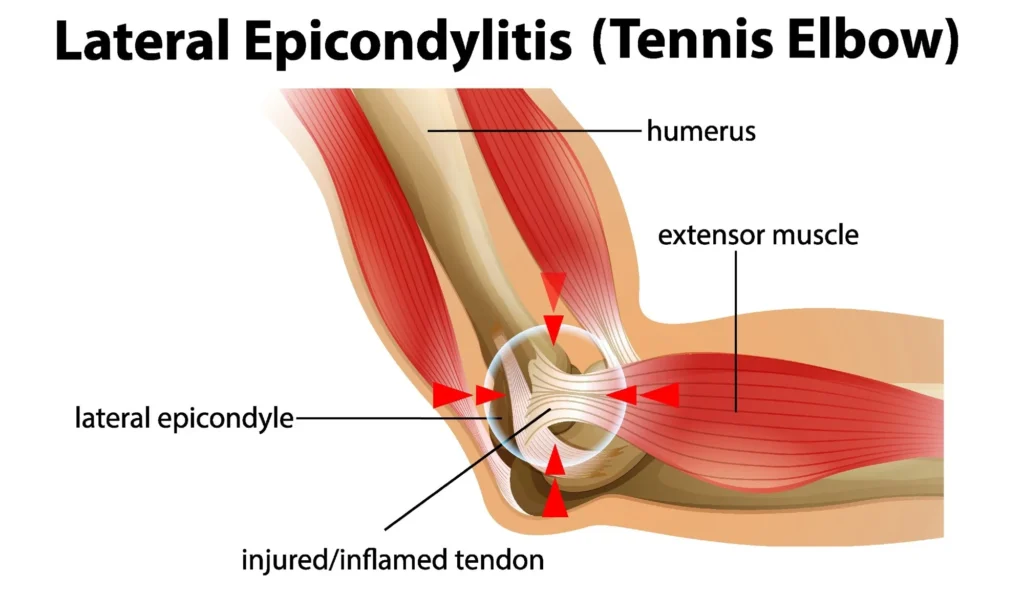A layman’s guide to tennis elbow
Tennis elbow (or lateral epicondylitis to give it its medical name) is a common affliction for padel players. It is both annoying and really painful, as Neil Bilton discovered when he developed the condition. Here he charts its onset, his recovery and gives layman’s advice for dealing with it.
Let’s start with a disclaimer. I am not a doctor or a physio or a faith healer but I have, and still do occasionally, suffer from tennis elbow. All advice below is from a layman and drawn from my own experience.
If you haven’t suffered from tennis elbow you are one of the lucky ones. If you have, then you know all about that innocuous pain which isn’t really there until you pick up a scalding hot cup of coffee and your elbow screams so loud you spill it on yourself, or when turning the key in your front door hurts so much you think about living in the garden for the rest of your life.
The onset is sudden, the pain very, very nasty and the length of the healing process is just too long to be acceptable.
Within the group of guys I play with, 70% have experienced it at some point. We all come from different disciplines of racket sports so it’s not a specific sport that makes you susceptible. My friend Richard (Bowles) and I have had it with differing levels of pain (but obviously mine was significantly worse than his).

What is tennis elbow?
It’s basically inflammation of the tendon where the forearm muscle connects to the elbow joint. It normally happens because of an injury or overuse of the muscle which then won’t move properly and so the tendon needs to compensate (tendons aren’t really designed to stretch and move around like muscles). Eventually the tendon rubs the bone entry point and becomes inflamed. Then it just hurts. A lot. It can be caused by lots of different things. From shoulder mobility, tight forearm muscles, a wrist strain or even an impact injury to a finger. You feel it, you hate it, you pray it will just go away and then you mentally cry a little.
How to dealt with it
Richard and I are different people, we behave differently, sometimes impatiently, sometimes aggressively and sometimes stupidly. We have both gone down the physio route, do this, do that and REST. We have gone down the YouTube self-heal route – do this, don’t do that and REST. And we have gone down the enforced lockdown route, do nothing (while getting fat) and being forced to REST. To be fair the latter one did work somewhat but it’s not that practical on a long term basis.

Rest definitely helps. And it gives you no idea of when to start playing again. Many a false start has occurred which immediately puts your 2-3 week rest period back to square one.
Get some ice on it when you feel it or when you aggravate it. While that bag of peas is slowly defrosting think about your rehab period because right now it’s a waiting game. When you decide to go back to padel you are probably going to need a pressure strap. We have tried several and we have found that the main thing is that it should be reasonably tight. The cheaper ones will come loose quite often during play and will need to be tightened regularly but everyone has different budgets and that, obviously, will affect your choice.
The strap effectively shortens the muscle and ‘locks off’ the point at which the tendon moves and hurts. Always follow the strap instructions. We found straps useful as a rehab tool after the REST period. We do not think a strap should be bought as an alternative to the REST period.
Warm-ups
This is something we should all do but they generally seem to amount to the last 30 seconds before going on court, having arrived 30 seconds before that. Amongst our friends what seems to count as as a warm-up can be as short as a couple of (tight) hamstring stretches or maybe one knee-clicking squat. Then it’s straight onto court to smash balls at each other as hard as we can across the net.
I now get to court 15 minutes early and have made warming up part of my padel routine. I do some simple arm swings, shoulder rotations and then begin to mimic certain padel shots but without the racket. I then add the padel racket and repeat the process with the added weight and air resistance that the racket brings. I lightly stretch my shoulders and wrists against a wall. All this takes me about five minutes and since I started doing it I’ve had no issues with tennis elbow. Richard was doing this with me until his elbow got better and he stopped. He got tennis elbow again.
Going forward I will say that I have previously suffered from ‘Padel Elbow’. It’s the same thing as tennis elbow but just that little bit cooler. Kind of the same as Richard and me, we are both men of roughly the same age but I am just that little bit cooler! 🎾




